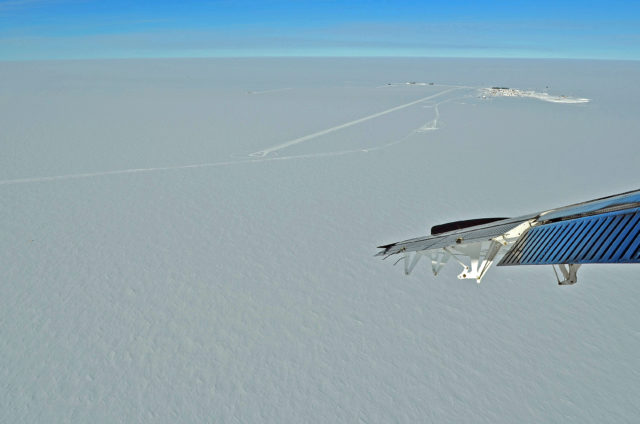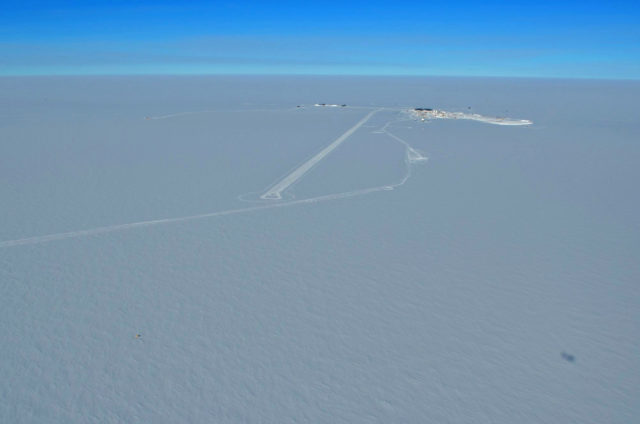The first planes of the season arrived two day ago — a Twin Otter and a Basler — two small aircraft en route to McMurdo. They came, stayed just long enough to refuel, see the sites, and grab a bite to eat. Then they left.

The first plane to arrive since mid-February spent a little less than 2 hours on station. Smaller aircraft don’t have the range to cross from New Zealand to Antarctica directly, so they leave from southern Chile, cross the Drake Passage and fly onward to Ross Island, using several bases, including the South Pole, as pit stops. (Photo: D. Lukkari)
Over 200 hours had been put into the skiway to prepare for their arrival. Heavy equipment operators worked on a 24-hour rotation, flattening drifts and leveling 3,600 meters (12,000 feet) of ice cap. Meteorological personnel dug out buried approach markers, some of which stood nearly 6.5 kilometers away from the nearest buildings. The utility technicians erected a fueling station and extended our electrical grid to the flight line.
Hundreds of hours of work to prepare for less than two hours of flight operations. It didn’t seem fair; a tease to the start of summer. Where were our replacements, the summer crew? Where were the crates of fresh fruit, our promised cornucopias of oranges, apples and kiwis?

The first plane of the summer circles as it prepares to land on the Jack F. Paulus Skiway at the Amundson-Scott Station. (Photo: H. Davis)
All we have now is an empty runway. We watch it slowly disappear– erased by blowing snow and the primordial ebbs and flows of the continent.
“I won’t let the lack of aircraft lead to the skiway’s abandon,” I tell myself. “We put a ton of work into it, and it would be good for station morale to see it used.” So, dressed in my Antarctic running uniform – two pairs of wool tights, a black fleece sweater, a grey down pullover, a pair of well-used softshell pants, a baggy windbreaker, a ski cap and a thin, red polypropylene neck gator – I embark on a 6.5 kilo run, from the station to the end of the runway and back.
The snow is still soft, freshly groomed, and my feet sink in a bit with each pace—like running in loose sand. It’s tiring, and soon my calves swell with exertion and sweat begins to dribble from the edge of my hat and freeze on top of my nose and eyebrows.
Soon, I discover that running inside the wide, smooth, packed ski tracks left behind by the planes when they landed and took off, requires slightly less effort. The bamboo flag lines that mark the edges of the skiway tick by—every 60 meters another set of them disappears behind me.

The skiway’s 3,600 meter expanse can be clearly seen in an aerial photograph. To prepare it each year for flights can take upwards of a week of operations. (Photo: H. Davis)
If I were a plane, I’d already be done. I’d be back in the station with a hot cup of mint tea and honey, or sitting in the sauna reading some degenerate gonzo journalism. It’s been 20 minutes since I reached the end of the runway and turned around, and it was only then that I realized that a breeze had picked up and the temperature had dropped.
The colder I get, the more aware I become of my lack of headway, the slower the bamboo flags stream past me. It’s to the point where it feels like I’m running backwards, as if the earth were spinning against me like a giant treadmill calibrated just beyond my pace. My left eye is frozen shut with sweat, and the eyelashes on my right eye are so caked with ice that when I look into the distance it feels like I’m peering through a cracked pane of glass.
My radio (I always carry one) is hooked to the waistband on my pants. I touch it for reassurance and think about stopping and calling for a snowmobile. The wind freshens some more, and I grit my teeth against the cold, adjusting my neck gator to better protect my nose. I’m cold, but I keep on running. I’m as stubborn as the continent I stand on.






















Comments are closed.